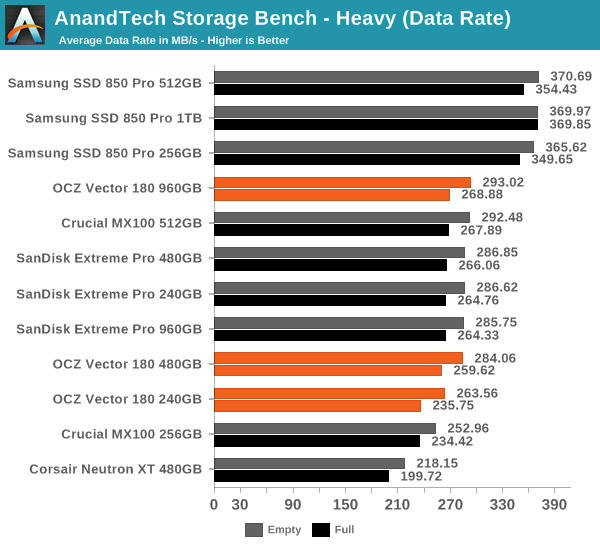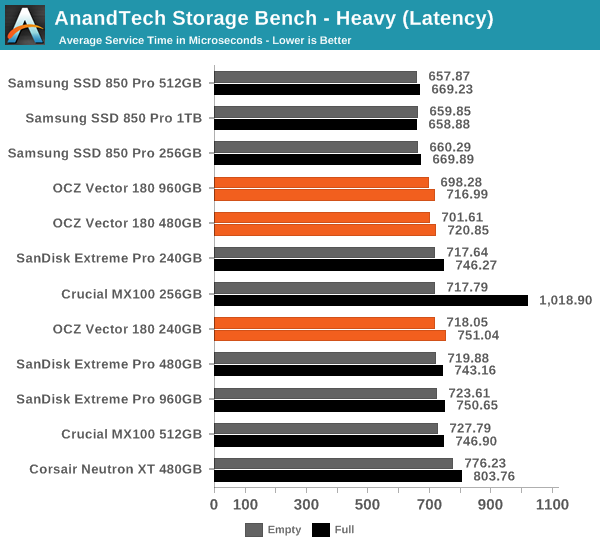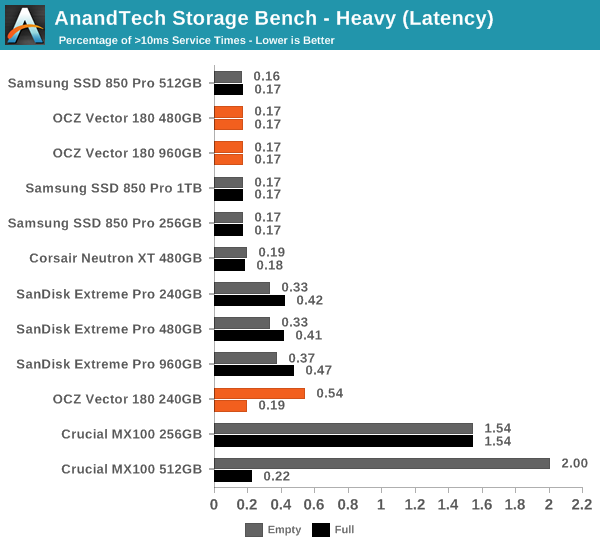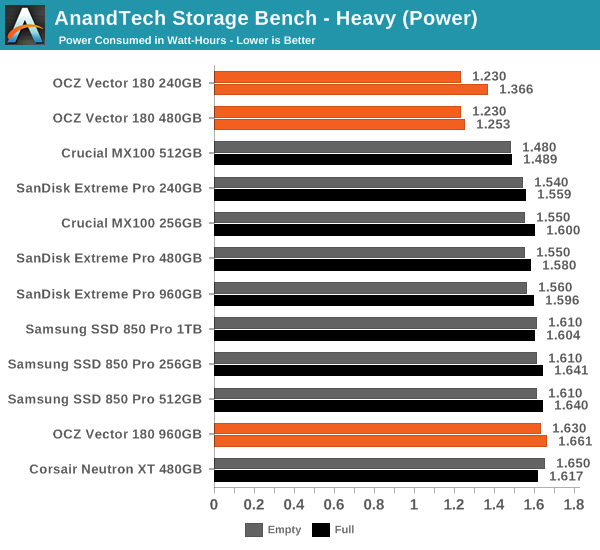The OCZ Vector 180 (240GB, 480GB & 960GB) SSD Review
by Kristian Vättö on March 24, 2015 2:00 PM EST- Posted in
- Storage
- SSDs
- OCZ
- Barefoot 3
- Vector 180
AnandTech Storage Bench - Heavy
While The Destroyer focuses on sustained and worst-case performance by hammering the drive with nearly 1TB worth of writes, the Heavy trace provides a more typical enthusiast and power user workload. By writing less to the drive, the Heavy trace doesn't drive the SSD into steady-state and thus the trace gives us a good idea of peak performance combined with some basic garbage collection routines.
| AnandTech Storage Bench - Heavy | ||||||||||||
| Workload | Description | Applications Used | ||||||||||
| Photo Editing | Import images, edit, export | Adobe Photoshop | ||||||||||
| Gaming | Pllay games, load levels | Starcraft II, World of Warcraft | ||||||||||
| Content Creation | HTML editing | Dreamweaver | ||||||||||
| General Productivity | Browse the web, manage local email, document creation, application install, virus/malware scan | Chrome, IE10, Outlook, Windows 8, AxCrypt, uTorrent, AdAware | ||||||||||
| Application Development | Compile Chromium | Visual Studio 2008 | ||||||||||
The Heavy trace drops virtualization from the equation and goes a bit lighter on photo editing and gaming, making it more relevant to the majority of end-users.
| AnandTech Storage Bench - Heavy - Specs | ||||||||||||
| Reads | 2.17 million | |||||||||||
| Writes | 1.78 million | |||||||||||
| Total IO Operations | 3.99 million | |||||||||||
| Total GB Read | 48.63 GB | |||||||||||
| Total GB Written | 106.32 GB | |||||||||||
| Average Queue Depth | ~4.6 | |||||||||||
| Focus | Peak IO, basic GC routines | |||||||||||
The Heavy trace is actually more write-centric than The Destroyer is. A part of that is explained by the lack of virtualization because operating systems tend to be read-intensive, be that a local or virtual system. The total number of IOs is less than 10% of The Destroyer's IOs, so the Heavy trace is much easier for the drive and doesn't even overwrite the drive once.
| AnandTech Storage Bench - Heavy - IO Breakdown | |||||||||||
| IO Size | <4KB | 4KB | 8KB | 16KB | 32KB | 64KB | 128KB | ||||
| % of Total | 7.8% | 29.2% | 3.5% | 10.3% | 10.8% | 4.1% | 21.7% | ||||
The Heavy trace has more focus on 16KB and 32KB IO sizes, but more than half of the IOs are still either 4KB or 128KB. About 43% of the IOs are sequential with the rest being slightly more full random than pseudo-random.
| AnandTech Storage Bench - Heavy - QD Breakdown | ||||||||||||
| Queue Depth | 1 | 2 | 3 | 4-5 | 6-10 | 11-20 | 21-32 | >32 | ||||
| % of Total | 63.5% | 10.4% | 5.1% | 5.0% | 6.4% | 6.0% | 3.2% | 0.3% | ||||
In terms of queue depths the Heavy trace is even more focused on very low queue depths with three fourths happening at queue depth of one or two.
I'm reporting the same performance metrics as in The Destroyer benchmark, but I'm running the drive in both empty and full states. Some manufacturers tend to focus intensively on peak performance on an empty drive, but in reality the drive will always contain some data. Testing the drive in full state gives us valuable information whether the drive loses performance once it's filled with data.

It sure seems like Samsung is the only manufacturer that has figured out a secret recipe to boost throughput with SATA 6Gbps because all the other drives are hitting a wall at ~290MB/s.

In terms of latency the difference between all drives is much more marginal. The Vector 180 has a small advantage over the Extreme Pro at larger capacities, although once again the 850 Pro tops the charts.

The Vector 180 is also very consistent with only a small number of >10ms IOs. Oddly enough, the 240GB does better when it's full, although I think that might be just an anomaly since it practically makes no sense at all.

Similar to what we saw in The Destroyer benchmark, the 240GB and 480GB Vector 180 has wonderful load power characteristics and the difference to other drives is actually fairly significant.










89 Comments
View All Comments
Guspaz - Tuesday, March 24, 2015 - link
Well, one person in particular had difficulty remembering the proper saying while in Tennessee...Minion4Hire - Tuesday, March 24, 2015 - link
He's quoting George Bush.mapesdhs - Wednesday, March 25, 2015 - link
And hence not exactly a viable rationale for concluding anything about anything.Ian.
CaedenV - Tuesday, March 24, 2015 - link
Cant beat the Evo on price, performance, or support... so then what is the point?kmmatney - Tuesday, March 24, 2015 - link
None of the benchmarks include the EVO, so it's hard to tell if it beats it or not. It is probably faster, but the MSRP is the same as the 850 Pro, which definitely beats it in most tests.ocztosh - Tuesday, March 24, 2015 - link
Hi CaedenV, thank you for your feedback. The Vector 180 is designed for the high performance/workstation market and is not positioned versus the TLC based EVO. When it comes to best balance of performance/value our ARC series (based on MLC). We will be coming out with future products that push the value envelope that leverage Toshiba TLC.mapesdhs - Wednesday, March 25, 2015 - link
I was impressed with the Arc 100, it was quicker than I expected. Any data yet on returnrates? It would be interesting to know if it's been competitive with the 850 EVO in that regard.
Samsung has a strong reputation here. My main concern with the Vector 180 though is it will
appear too expensive compared to the 850 Pro and SanDisk Extreme Pro.
Ian.
chrnochime - Tuesday, March 24, 2015 - link
The point is some ppl don't actually want to use TLC.ocztosh - Wednesday, March 25, 2015 - link
Hi chrnochime, thank you for your comments. We so agree there are still a lot of customers that would still prefer MLC. Our current value drive series is MLC based and even after we introduce a TLC based Series we will continue to deliver MLC drives for those customers that are looking for drives higher up the performance spectrum.chrnochime - Tuesday, March 24, 2015 - link
Support? So how long did that TLC fix take to be available again?